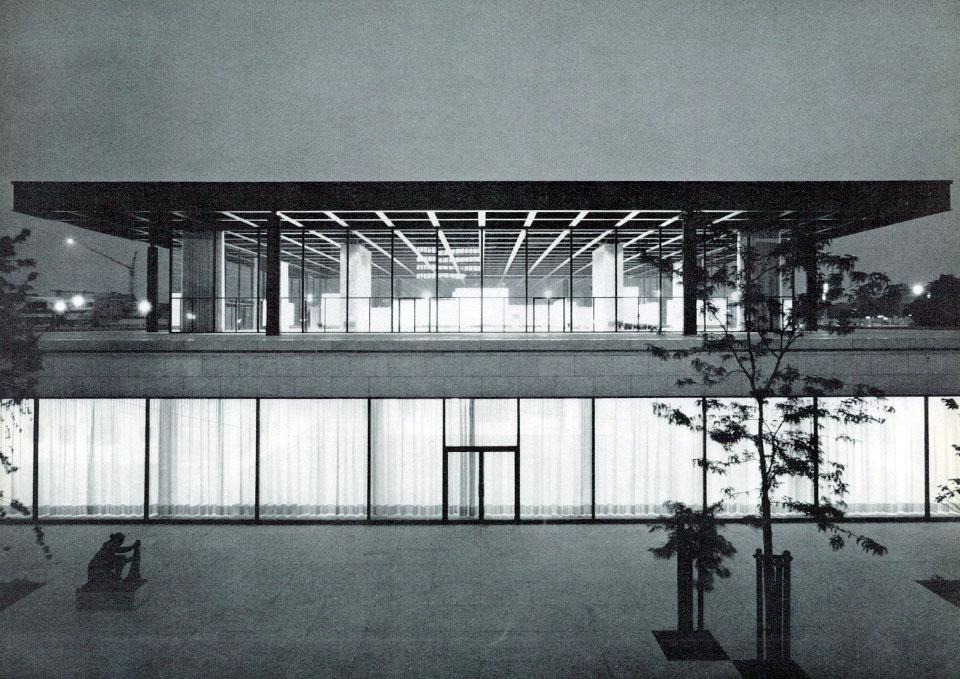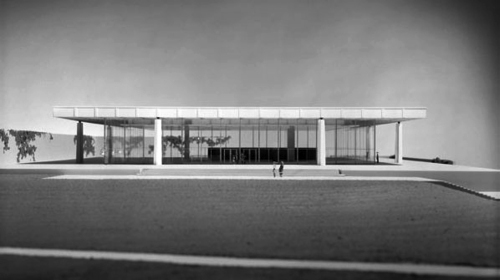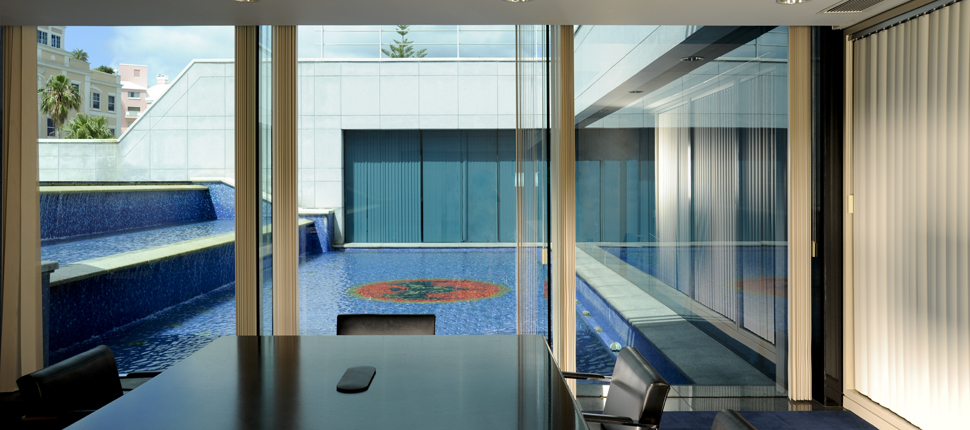Three years after Ludwig Mies (van der Rohe) passed away, as his buildings were being completed without him, a new one was added to the annals of his postmortem built works.1 The year was 1972, when the corporate conglomerate Bacardí Ltd. had consolidated its different branches across the world and unified them into new headquarters in the tax haven of Bermuda.2 The corporation hoped to capitalize on the symbolism of a Mies–inspired building in its branding, and commissioned the exiled Cuban architect Ricardo Eguilior on behalf of the recently deceased architect. He blended two original Miesian works into a new formula—the unbuilt proposal for Bacardí’s headquarters in Santiago de Cuba, originally sketched without even visiting the site, together with the Neue Nationalgalerie in Berlin. Among many contributions to architecture, Mies van der Rohe has played a significant role in the development of a multinational corporate style. His glass-and-steel minimalism was adapted by other moderns like Eero Saarinen, Minoru Yamasaki, or the partners of SOM, into corporate towers in cities around the world. However, we shall see how the iconic temple in Hamilton, Bermuda, epitomizes a copy of a building lacking an original.3 In Hamilton, the model of Miesian transnational corporate space supersedes his own original work.


There are conflicting sources and confusion about the authorship of Bacardí’s Bermuda HQ. The company’s website claims the building is actually designed by Mies van der Rohe.4 In order to fabricate ties between an architect and a building he never designed, the corporate giant even organized a public event at the Neue Nationalgalerie in August 2010. It celebrated the resemblances between both buildings, almost as if the Bermudian illegitimate child had to publicly demonstrate who her real father was. By simply comparing the glass walls of the museum and the headquarters, the discrepancies, though, become clear. For the German building, Mies deployed vast expanses of plate glass for the glass walls, supported by custom-fabricated steel mullions at the vertical joints, while for the Bermuda building Eguillior chose a more modestly dimensioned butt-glazed system with glass fins at the vertical joints to provide lateral stiffness. In the former, structure and skin in the form of steel and glass are integrated into a stark architectural expression. The latter does away with this starkness in favor of a redoubled commitment to transparency, fitting for the corporation.
However, as architectural replicas circumnavigate the globe, we should move beyond adjudicating “good” or “bad” copies to better understand similarities between products within the built environment. The binary of original/copy could be read through a different logic: The origin of the building and its genealogy expose the geopolitical negotiations that led to its making. In this sense the Bermudian corporation is quite honest—the headquarters’ clumsy architectural details reveal Bacardí’s 150-year history of struggling to keep the “originality” of the spirits through spatial, visual, or ingestible techniques.
Though Bacardí was founded in 1862, it was not until after World War I that it started to expand significantly. In 1919 the US Congress passed the National Prohibition Act (NPA, also popularly known as the Volstead Act) forbidding the manufacture, transportation, import, export, sale, and consumption of alcohol in the United States. This not only reimagined the borders of a dry country, it also affected the global production of architecture. To the south, the reach of the nation spanned the Gulf of Mexico to Cuba, where Havana was turned into an extraterritorial saloon. Bacardí Rum, at that time a mere local distillery, profited from its Caribbean locale by attracting thirsty American tourists. If the islands of the Caribbean were watering holes to the south, in the north Canada became the cross-border liquor-aging depot. Local Seagram’s Whiskey provided smugglers with goods while Canada became an incubator for the well-aged seven-year whiskey that would flood the US market once Prohibition ended. In Cuba, location was crucial in circulating people to alcohol, whereas in Canada time played a decisive role in in circulating alcohol to people. By 1929, Seagram’s Whiskey and Bacardí Rum, had grown to become two of the largest distilleries in the world, and in that year they both found themselves in the Chrysler Building. It was precisely the prohibition on alcohol that allowed Seagram’s-made-in-Canada-Whiskey and Bacardí-made-in-Cuba-Rum to afford exclusive office space in the tallest building in the world, in a country where they could not sell a drop of their product at that time.
Having accumulated a fortune out of the unbalanced regimes on different sides of the border, both brands continued to grow internationally once Prohibition ended in 1933. They strategically chose their production sites not only according to new frontiers for market expansion, but also according to the landscapes and buildings representative of a new economy. After World War II, advances in production and the abatement of the Depression signaled an era of mass-consumerism to come. During this time both Seagram’s and Bacardí decided to build new headquarters that would reimagine their connection, or geographical disconnection, to both Canada and Cuba. Built by Mies van der Rohe with Philip Johnson 1954–58—under the obstinate, visionary desires of Phyllis Lambert, the owner’s daughter—Seagram’s new New York headquarters constituted a new approach to a global corporate style. It was a paradigmatic moment in which the neutral architecture of an office tower was superseded by the open plaza in front of it. The architects’ refusal to maximize the building area in one of the most exclusive zones of Manhattan became the best possible branding strategy for a dislocated liquor company. This strategy achieved such a level of iconicity that the building seemed to need no address; it was simply referred to as The Seagram’s Building. Its architectural gravitas even opened a public debate around the discrepancy between the building’s actual cost and its market value.5 Only a few years after its completion, the New York City Tax Commission tried to add a luxury tax to the quality of its architecture, leading to a court case, where the aesthetic merit of the building was judged to determine whether it possessed taxable value as advertising.6
Meanwhile in Cuba, José Bosch, the head of Bacardí Rum, who had supported Fidel Castro in the overthrow of dictator Batista, had to quickly leave the country as Fidel nationalized the company and expropriated all its Cuban assets in1960. Bosch had, only a few years earlier, commissioned Mies to replicate the “Seagram’s effect” with a proposal for headquarters in Santiago de Cuba (1957). Now, the distiller had to flee and leave behind his hopes that “now that we have democracy and justice in Cuba, we can get this building built.” The brand had to abandon the Santiago de Cuba plan, but it did not give up on Mies. It reconfigured the Caribbean imaginary by appropriating the Miesian model of international modern architecture as a basis to reinvent itself abroad. In the words of Allan Shulman, “Bacardí was a company in exile, a transnational body with worldwide assets and a Pan-American identity. It was an archipelago of industry and administration that was a forerunner of today’s globalized enterprises.”7 The conflict around Bacardí’s nationalized assets has been reactivated more recently after Barack Obama’s attempts to bring the Cuban embargo to an end. The lack of market exchange between Cuba and the United States has so far materialized in the bipolar ownership of another rum brand, Havana Club, which was also nationalized after the Revolution. Bacardí bought the brand from its original owners and has been selling Havana Club in the United States and its territories as Puerto Rican rum. At the same time, the Cuban government in partnership with global corporatation Pernod Ricard, sells a different Havana Club internationally, except for in the United States and its territories. Bacardí continues to fight Cuba in courts aiming to legalize their own Havana Club trademark outside the United States.

While Bacardí facilities initially relied on the colonial-tropical imaginary of seventeenth century Jesuit churches and the monumentalization of their idolized coconut tree, by the 1950s the company sought out spaces produced by the corporate avant-garde. Their facility in Tultitlán, Mexico (1957–61) was another Mies commission, and the bottling plant within the complex was built by Félix Candela (1958–60). The Bacardí Pavilion in Cataño, Puerto Rico, was so Candela-inspired as to be called Candela-esque (though it was designed by CMA Architects and Engineers LLP, ca. 1960).8 Shulman has also remarked how the economy was actually not the primary driver in Bacardí’s projects; the driver was the power of architecture. Architecture could enhance the image of the company, which would in turn deliver a powerful message about its corporate culture and about Bacardí’s emerging role in the American hemisphere.9 As a clear example of the universal transcendence of the design, and regardless of the veracity of its actual symbolism, it has been reported that Eguilior superimposed several plexiglass crystal cubes over the ceiling of the Bermuda HQ to re-create the exact position of the constellations as they appeared in the skies over Santiago de Cuba on the night of February 4, 1862, the date upon which Bacardí was first founded.10
Such a cloying relationship to the past is also present in another Bacardí sub-brand: Bombay Sapphire Gin, which was created in 1987 and acquired by the rum giant in 1998. Even if the brand has existed for fewer than thirty years, its branding still takes cues from Victorian colonial times, detailing everything from bottles to website in a ruse of heritage. Even the labeling of the spirit invokes a spatio-temporal construct of the past—“Bombay” (instead of Mumbai) links the gin to the times of the English East India Company; “sapphire” conjures precious gemstones and exotic mines depicted in, for example, Indiana Jones’ filmography; and the headshot of Queen Victoria smacks of the seventeenth century. In his Semiotics of Drink and Drinking, Paul Manning remarks how the list of ingredients provides their gin with its significant taste based on claims of origin from Java or Indo-China, despite the fact that these territories were not even under British Imperial rule.11 Even more interesting are the new headquarters that the brand recently commissioned to Heatherwick Studio. The new facility sits on a heritage-listed 1718-built corn mill, of course exploited for its rustic, nostalgic appeal.12 The resulting building is shaped as a Victorian greenhouse, along the lines of Kew Gardens.13 Those Imperial botanical machines were initially devised not as recreational gardens but rather for purely agricultural purposes—to steal seeds from foreign tropical nations, study them, reproduce them, and transplant them to other overseas territories so as to have the trade of spices, rubber, cocoa, or fruits under the control of the Empire.
Keeping up with the spread of the company at a multinational level, the Mies-inspired building in Bermuda underwent a process of underground expansion in 2000, with the commission going to to the corporate giant OBM International. The refurbishment added 16,000 square feet to the original structure (though the Barcelona-looking chairs in the lobby remained).14 One of the major additions is a semi-basement courtyard under the podium of the building that the 1972 version had forgotten to copy from the Neue Nationalgalerie. To make room for it, Eguilior’s ornamental fountain was dismantled, transformed into smaller waterfalls, and displaced to the sides of the main elevation. The new landscaping of the void in front of the building also includes the addition of two symmetrical tile-paved ramps to allow a clockwise circulation of cars to the entrance of the building at the first level.15 Exposing the basement of the building to the arriving visitor translates the inner corporate function in superlative fashion. Even before arriving at the reception lobby on the grand floor, it is the new meeting rooms that one sees upon entering, close enough for the visitor to perceive the relevance of the deals taking place but distant enough to obscure what is actually happening. This gesture, exposing the shiny “important” tables and leather office chairs, suggests that the headquarters are there for real working meetings, that the building is not just in Bermuda as an empty tax haven.
After the death of Mies, his basements seemed to emerge out of the ground to reveal their daily interior activity and proof that the building is actually inhabited and has a proper function, contrary to its apparent aesthetic form. PHANTOM: Mies as Rendered Society (2012), an installation by Andrés Jaque that relocates materials from the basement of Mies’s Barcelona Pavilion (1929) into its galleries, showed the “absence of the ordinary” that is usually hidden in the classic Miesian scheme. On the podium surface, Jaque’s installation displayed a series of historic and everyday events that had happened in the building through the objects stored in its forgotten underbelly.16 By giving the cleaner’s mop and bucket, for instance, a prominent role in the overall display, we are reminded that minimalist perfection contains a whole layer of tedious labor behind the spotless travertine.

Going even deeper in the ground, Bacardí celebrated its 150th anniversary by creating a time capsule in 2012 that is only to be opened in 2062.17 They manufactured a 6-foot-long custom-made steel cylinder, filled it, and buried it in the open void in front of the Miesian building. Among its contents—a letter written in an ancient style of Chinese characters by China-based Bacardí employees; a rum ad marking the anniversary broadcast on a twenty-three-story-tall electronic billboard in New York City’s Times Square; their first TV ad for apple-flavor rum in Brazil (one of the company’s fastest-growing markets in Latin America); a decorated African storage gourd, an important cultural and social symbol shared among friends in Kenya (one of their newest markets); and a list of the top music downloads that year. If architectural landmarks seemed to have played a decisive role in creating the imaginary of a Caribbean spirit in the past, the 2012 time capsule exposes the reliance on a global geography of pop culture as a way to present a corporate conglomerate to the archaeology of the future.
The materials that led to this text were two lecture-performances by the authors: Now That We Have Democracy [in Cuba], We Can Get This Building Built, at the Neue Nationalgalerie, Berlin, 2014; and From Made Into Made Nowhere, for the Visual Cultures Spring Public Program, Goldsmiths, University of London, 2015.
-
The four buildings were: One Illinois Center, Chicago 1970; Martin Luther King Jr. Memorial Library, Washington, D.C., 1972; American Life Building, Louisville, Kentucky, 1973; and IBM Plaza, Chicago, 1973. ↩
-
The original family name Bacardí, of Catalan/Cuban origin, ends with a tilde over the i: í. Although the global character of the brand does not allow it to reproduce the “correct” spelling on a URL domain (www.bacardi.com), the graphic identity of the brand introduces this bilingual orthographic ambiguity through a hybrid between a dot and an oblique dash over its last vowel. This text intentionally keeps its original spelling, which links it back to the Cuban geography from which the rum manufacturer had to escape. ↩
-
Gilles Deleuze, “Plato and the Simulacrum,” trans. Rosalind Krauss, October 27 (1983): 45–56. ↩
-
“Bacardi’s global headquarters, designed by Ludwig Mies van der Rohe.” Andrew Braithwaite, “Bermuda Sports Triangle,” AirCanada enRoute, January 30, 2014,enroute.aircanada.com/en/articles/bermuda/page:2. “Bacardi Limited opened offices in Bermuda in 1965 and moved into its current Ludwig Mies van der Rohe–designed landmark building in 1972.” “Bacardi Limited at a Glance,” bacardilimited.com/PressRelease/FactSheet. ↩
-
Felicity D. Scott, “An Army of Soldiers or a Meadow: The Seagram Building and the ‘Art of Modern Architecture,’” Journal of the Society of Architectural Historians, vol. 3, no. 70: 342. ↩
-
Scott, “An Army of Soldiers or a Meadow,” 343–344. ↩
-
Allan Shulman, “The Mixable One: Two Projects for Compañía Ron Bacardi S.A.,” Paper presented at X Seminário Docomomo Brasil, University of Miami School of Architecture, October 2013, 5. ↩
-
Kathryn E. O’Rourke, “Mies and Bacardi: Mixing Modernism, ca. 1960,” Journal of Architectural Education, vol. 1, no. 66 (2012): 57–71. ↩
-
Shulman, “The Mixable One,” 3. ↩
-
Celia Musson-Nzabalinda, “Legacy of a Premium Company,” BDASUN, February 2, 2012, bermudasun.bm/Content/FEATURES/Bacardi-150th-Anniversary-Special-Edition/Article/Legacy-of-a-Premium-Company/60/1107/56652. ↩
-
Paul Manning, Semiotics of Drink and Drinking, (London and New York: Continuum, 2012). ↩
-
“Distillery,” bombaysapphire.com, distillery.bombaysapphire.com/the-distillery/laverstoke-mill/heritage. ↩
-
“Bombay Sapphire Distillery,” Heatherwick studio, heatherwick.com/distillery. ↩
-
“Bacardi—Hamilton, Bermuda,” OMBI, obmi.com/inside-design/bacardi. ↩
-
It is worth noting that the HQ and their open void in Bermuda sit in a suburban landscape, very different from the location of The Seagram’s Plaza in Manhattan. ↩
-
“Andrés Jaque. PHANTOM. Mies as Rendered Society,” Fundacio Mies van der Rohe Barcelona, miesbcn.com/project/jaque-intervention. ↩
-
It has been approved by the International Time Capsule Society (ITCS), which estimates that there are between 10,000–15,000 existing time capsules worldwide. See: “Bacardi Marks 150 Years with Time Capsule,” Bernews, December 13, 2012, bernews.com/2012/12/video-bacardi-marks-150-yrs-with-time-capsule. ↩
Cooking Sections (Daniel Fernández Pascual & Alon Schwabe) is a duo of spatial practitioners based out of London. It was born to explore the systems that organize the WORLD through FOOD.

